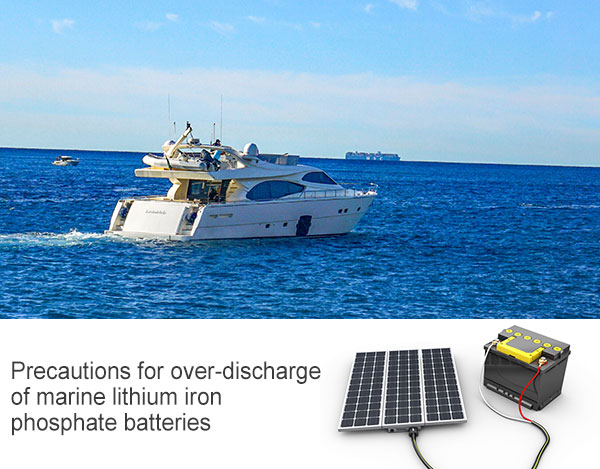What will happen to the overdischarge of marine liFePo4 batteries?
Lithium dendrites are easily formed at the positive electrode of the battery due to overcharging of the lithium-ion battery, and the puncture of the separator leads to an internal short circuit of the positive and negative electrodes of the battery, and further leads to thermal runaway of the battery cell, causing fire or explosion.
Therefore, great attention is paid to the safety and protection of lithium-ion battery overcharge. In each standard, the test requirements of the overcharge safety test items are consistent.
However, during the over-discharge process, the battery energy changes in a decreasing direction, so it is unlikely to cause fire or explosion. In each standard, especially under the GB and IEC standard systems, the test requirements of the overdischarge test are significantly different.

Requirements for overdischarge of marine liFePo4 batteries
At present, because lithium-ion batteries are widely used in the field of electric vehicles, the standards for lithium-ion batteries are mainly aimed at electric vehicles. In recent years, with the further application of lithium-ion batteries in the fields of industry and power storage, application standards for lithium-ion batteries in related professional fields have also begun to appear.
In the field of marine lithium batteries, due to the fact that its application has just started, there is a lack of special standards for the time being. The main performance test and safety test requirements are based on relevant standards in the fields of automobiles, industry and power storage.
Among them, in “Solar Photovoltaic System and Lfpo4 Battery System”, the main acceptance standard for safety test is “Secondary Lithium-Ion Battery for Propulsion of Electric Road Vehicles” Part 2: Reliability and Abuse Test.
Discussion on Overdischarge of Marine liFePo4 Batteries
As far as the over-discharge test items are concerned, the requirements of the single battery vary with its use environment. The intended use of single cells to which GB/T 36276 is applicable is for electrical energy storage. This type of battery system is usually on-line, connected to the power grid, and can replenish the discharged electricity from the power grid in time.
When used as a backup power supply for important equipment and places, the power load and power consumption time that the battery system needs to undertake can also be completely determined during design.
As a battery cell used for power storage, the discharge rate is required to be low during use, and overdischarge is not easy to occur.
When used as an automotive power battery, the main requirements for battery performance characteristics under its application conditions are: high specific energy, high output power, and long cycle life. In this case, the requirements for the battery are both high energy density and high discharge rate.
In the actual use process of electric vehicles, the driving habits of drivers and the distribution of charging stations will affect the battery system. At the same time, considering the large changes in environmental factors such as temperature, humidity, vibration and shock in the use conditions, the consistency of battery cells may change significantly compared with the factory.
As far as overdischarge is concerned, electric vehicle batteries are prone to overdischarge to a certain depth under high-rate discharge conditions.
When the battery is used as the power source for ship propulsion, since the sensitivity of the ship to the weight of the battery is much smaller than that of the car, and its endurance is the focus of the battery capacity design, the marine lithium battery does not need high power output, so the discharge The magnification requirement is not high.
However, the use environment on board is slightly better than that of electric vehicles, but it is also worse than the use environment of batteries for power storage, so the consistency guarantee of battery cells during use is not as good as batteries for power storage. At the same time, due to the influence of wind and waves on the speed and propulsion load, the greater the wind and waves, the greater the propulsion resistance of the ship.
Since pure battery-powered ships can only be charged with shore power after arriving at the port, this may lead to a deep discharge depth of battery cells under certain harsh sea conditions. To sum up, when a lfpo4 battery is used as a power source for ship propulsion, the discharge rate of the battery cell during overdischarge is not high, but the discharge depth may be large. The requirements of its overdischarge test should be compatible with the overdischarge conditions that may occur during its use.
Several suggestions for overdischarge of liFePo4 batteries
(1) Because the lfpo4 battery has good over-discharge resistance and is used as a power source for ship propulsion, it may have a deep discharge depth, and its over-discharge depth should consider stricter requirements. The discharged battery SOC=-150%.
(2) Due to the low discharge rate of the battery cell in the actual marine working condition, the discharge current of overdischarge can be considered to be the smaller value of 1C or the maximum discharge current specified by the factory.
(3) If the selected discharge current is less than 1C, the discharge time needs to be extended to ensure the depth of discharge. The actual discharge time is equal to the ratio of 1C to the actual discharge current multiplied by 90 minutes.




